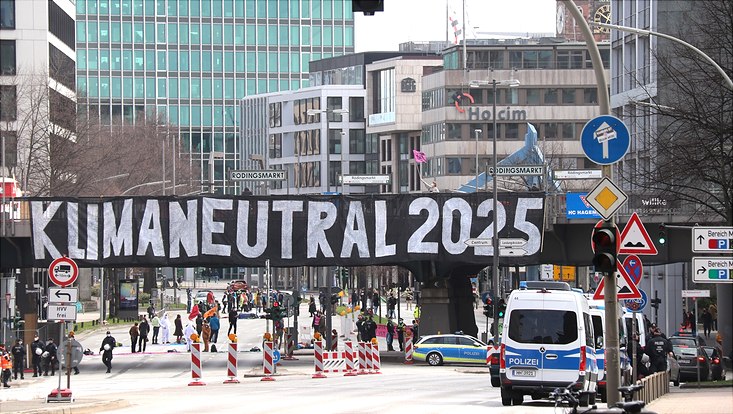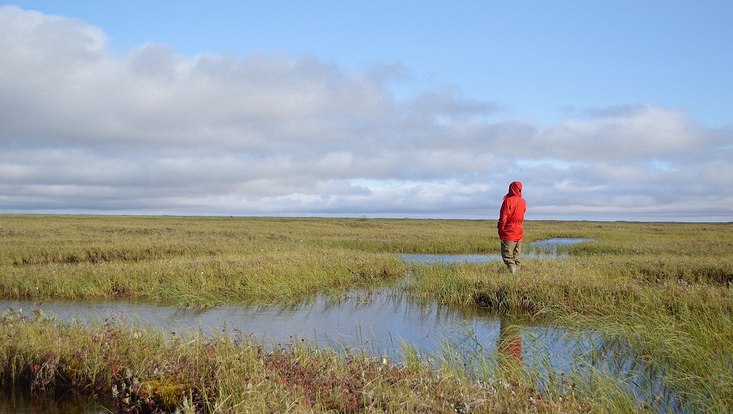and Society (CLICCS)
Using sea-level rise to define climate targets
9 January 2020, by Stephanie Janssen

Photo: J. Zapata/unsplash
One major consequence of global warming is the rising sea level. A study conducted at Universität Hamburg’s Cluster of Excellence for climate research CLICCS now shows: if we assume that sea-level rise is the most critical effect of climate change, then it is not only more sensible, but also less expensive, to set a maximum limit for sea-level rise that corresponds to the two-degree target, rather than a temperature-based target.
To date, climate protection targets have consistently been oriented on the mean global temperature, just as defined in the Paris Agreement: the goal is to limit mean warming to 2 degrees, or ideally, to 1.5 degrees Celsius. A joint research team from the Max Planck Institute for Meteorology and Universität Hamburg has now converted these temperature-based targets into sea-level-based equivalents. The team’s goal is to spark a new discourse concerning whether, and if so, how, climate targets should be adapted once we know more about the impacts of climate change. The study has just been published in the journal Science Advances.
Rising temperatures produce sea-level rise in three different ways: melting mountain glaciers, melting ice sheets, and the expansion of seawater produced by the additional warmth. Yet these processes are very slow and gradual, and the Earth’s massive oceans respond to them even more sluggishly. As a result, even if we theoretically stopped all greenhouse-gas emissions tomorrow, the sea level would still continue to rise for several centuries. The risks for coastal zones and small islands are on the rise.
The new path slows sea-level rise more effectively, even after 2200
Accordingly, critical factors for sea-level rise include not only how much carbon dioxide (CO2) is emitted worldwide, but also and especially when. There are a number of plausible variants, referred to as emissions paths. Global emissions could first be very high, then be dramatically reduced – or could be radically reduced first, and then continue at an intermediate level. The temperature rise by the year 2200 would be the same in either case; yet which emissions path is chosen certainly will have an effect on long-term sea-level changes. The general rule of thumb: the sooner emissions are cut to zero, the sooner sea-level rise will begin slowing.
For their calculations, the experts used the two-degree target as the point of departure. If that goal is met, global sea-level rise is projected to reach ca. 0.89 meters by 2200. Consequently, they used this value as the new upper limit for sea-level rise, i.e., as their sea-level target. In turn, the team used computer models to determine which emissions path would allow us to reach it.
More time for innovations and technological adaptation
Their findings provide a path that, unlike the temperature-based target, initially allows higher emissions, but then calls for a cut to zero emissions by ca. 2100. By 2200, the path ends at the same global temperature and (coincidentally) the same total amount of emitted CO2. “The new path is considerably more sustainable, as it more effectively slows sea-level rise, including after 2200,” says Chao Li, the lead author of the study.
With the help of an economic model, the experts also demonstrated that using a sea-level target derived from a temperature goal is also the less expensive option. Different emissions paths necessitate different climate policies, which in turn entail climate protection measures with different price tags. “The extent to which CO2 emissions are reduced, and when they are reduced, also make a difference from a financial standpoint,” explains Hermann Held from Universität Hamburg, another of the study’s authors. “Basing our targets on the sea level would give society more time for innovations and technological adaptation. It’s a sound approach, assuming sea-level rise is considered to be the most pressing problem in connection with global warming. In contrast, one of the core ideas in the concept, namely, that we should orient climate targets as closely as possible on the impacts as soon as the latter have been identified, is universally applicable.”
Sea-level target provides rational justification of a certain temperature overshoot
Which path emissions take until 2200, i.e., how much is CO2 emitted and when, will have a direct effect on the mean temperature. For example, the initially higher emissions on the sea-level path would cause temperatures to first rise by somewhat more than two degrees – an overshoot of 0.3 degrees Celsius – and subsequently drop off again. “Exceeding the two-degree target in the short term, and cooling again farther down the line, can be determined by using the expected physical reactions in the ocean,” says Chao Li. “This is another advantage of the sea-level-target.” When it comes to the temperature-based target, overshooting the limit set in the Paris Agreement is not a scenario that is considered. It is currently being discussed in the research community, though with a certain degree of arbitrariness. In the concept presented here, the temperature-based target is defined by the maximum allowable sea-level rise, effectively capping it.
In the study, the team stresses that their work presents proof-of-concept study only; further efforts are required for practical applications. Nevertheless, their findings impressively show that a new climate target could simultaneously offer more certainty and more flexibility.
Original publication: Li C, Held H, Hokamp S, Marotzke J (2019): Optimal temperature overshoot profile found by limiting global sea-level rise as a lower-cost climate target; Science Advances LINK
Contact:
Dr. Chao Li
CLICCS – Cluster of Excellence for Climate Change
Max-Planck-Institut für Meteorologie
Bundesstr. 53, 20146 Hamburg
Tel.: +49 40 41173-458
E-Mail: chao.li"AT"mpimet.mpg.de
Prof. Dr. Hermann Held
CLICCS – Cluster of Excellence for Climate Change
CEN – Center for Earth System Research and Sustainability
Universität Hamburg
Tel.: +49 40 42838-7007
E-Mail: hermann.held"AT"uni-hamburg.de
Stephanie Janssen
Public Information Officer / Outreach
CLICCS – Cluster of Excellence for Climate Change
CEN – Center for Earth System Research and Sustainability
Universität Hamburg
Tel.: +49 40 42838-7596
E-Mail: stephanie.janssen"AT"uni-hamburg.de


